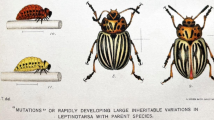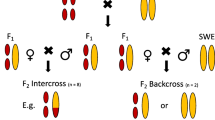Summary
Experiments were designed to examine whether heterosis would occur in crosses of Drosophila melanogaster populations adapted to 18 °C or 28 °C environments. Crosses were examined in parental environments, an intermediate environment (23 °C) and a mixed environment (alternating 18°/28°C). Parental populations did not show divergence for larval viability, cold shock or high temperature mortalities when tested in a common environment. However, the 28 °C population was less fecund than the 18 °C population, but had higher larval competitive ability and higher adult longevity. Heterosis for viability, cold shock mortality and high temperature mortality occurred in crosses between a population adapted to 18 °C and another adapted to 28 °C, but not in crosses between two populations adapted to the same temperature. The results suggest that, in the absence of drift, heterosis is expected in crosses between lines or populations with different histories of selection but not between lines with the same selection histories.
Similar content being viewed by others
References
Anderson WW (1966) Genetic divergence in M. Vetukhiv's experimental populations of Drosophila pseudoobscura. Genet Res 7:255–266
Bell AE (1982) The Tribolium model in animal breeding research. Proc. 2nd World Congr on Genet Appl to Livestock Production vol 5, pp 126–142
Bhuvanakumar CK, Lynch CB, Roberts RC, Hill WG (1985) Heterosis among lines of mice selected for body weight. 1. Growth Theor Appl Genet 71:44–51
Bhuvanakumar CK, Roberts RC, Hill WG (1985) Heterosis among lines of mice selected for body weight. 2. Reproduction. Theor Appl Genet 71:52–56
Ehiobu NG, Godhard ME, Taylor JF (1988) Effect of rate of inbreeding on inbreeding depression of Drosophila melanogaster. Theor Appl Genet 77:123–127
Falconer DS (1981) Introduction to quantitative genetics, 2nd ed. Longman, London New York
Frisch JE, Vercoe JE (1987) Utilizing breed differences in growth of cattle in the tropics. World Anim Rev 25:8–12
Kolstad N (1980) Scandinavian selection and crossbreeding experiment with laying hens. III. Results from the Norwegian part of the experiment. Acta Agric Scand 30: 261–287
Liljedahl L, Weyde C (1980) Scandinavian selection and crossbreeding experiment with laying hens. II. Results from the Swedish part of the experiment. Acta Agric Scand 30:237–260
Long T (1970) Genetic effects of fluctuating temperature in populations of Drosophila melanogaster. Genetics 66:401–416
Lynch CB, Roberts RC, Hill WG (1986) Hetrosis among lines of mice selected for body weight. 3. Thermoregulation. Genet Res 48:95–100
MacKay TFC (1981) Genetic variation in varying environments. Genet Res 37:79–93
Mourad AF (1965) Genetic divergence in M. Vetukhiv's experimental populations of Drosophila pseudoobscura. Genet Res 6:139–146
Oliveira AK de, Cordeiro AR (1980) Adaption of Drosophila willistoni experimental populations to extreme pH medium. II. Development of incipient reproductive isolation. Heredity 44:123–130
Powell JR, Wistrand H (1978) The effect of heterogeneous environments and a competitor on genetic variation in Drosophila. Am Nat 112:935–947
Rose MR (1982) Antagonistic pleiotropy, dominance and genetic variation. Heredity 48:63–78
Tantawy AO, Mallah GS (1961) Studies on natural populations of Drosophila. I. Heat resistance and geographic variation in Drosophila melanogaster and Drosophila simulans. Evolution 15:1–14
Wilhelmson M (1980) Breeding experiments with Japanese quail (Coturnix coturnix japonica). II. Comparison between index selection and specialized selection followed by crossing. Acta Agric Scand 30:373–387
Author information
Authors and Affiliations
Additional information
Communicated by J.S.F. Barker
Rights and permissions
About this article
Cite this article
Ehiobu, N.G., Goddard, M.E. Heterosis in crosses between lines of Drosophila melanogaster selected for adaptation to different environments. Theoret. Appl. Genetics 77, 253–259 (1989). https://doi.org/10.1007/BF00266195
Received:
Accepted:
Issue Date:
DOI: https://doi.org/10.1007/BF00266195




